Native America (1600-1810)
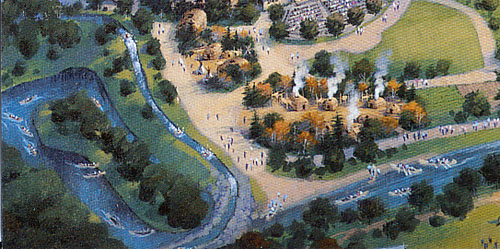
 The Native American aesthetic was definitely something that was in the air at Disney corporate during the development of Disney’s America. When Michael Eisner and Frank Wells toured Colonial Williamsburg at the behest of Dick Nunis in 1991, they were fresh off of one of the original story pitches for Pocahontas. As the park was developed in 1993 and 1994, Pocahontas was working its way to its 1995 release. Disney’s America would incorporate these eastern American Indian themes, giving Native Americans a presence in the park that they had not enjoyed since the early days of Disneyland’s Frontierland.
The Native American aesthetic was definitely something that was in the air at Disney corporate during the development of Disney’s America. When Michael Eisner and Frank Wells toured Colonial Williamsburg at the behest of Dick Nunis in 1991, they were fresh off of one of the original story pitches for Pocahontas. As the park was developed in 1993 and 1994, Pocahontas was working its way to its 1995 release. Disney’s America would incorporate these eastern American Indian themes, giving Native Americans a presence in the park that they had not enjoyed since the early days of Disneyland’s Frontierland.
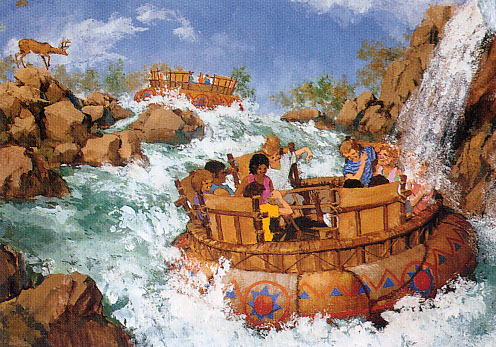
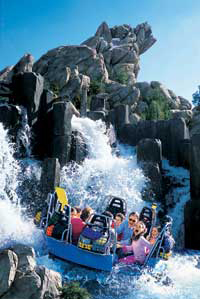 The territory would feature a recreation of a Powhatan Indian village, which can be seen in park renderings. The centerpiece of the area, however, would be the Lewis and Clark Raft Expedition. This whitewater raft attraction would feature “pounding rapids and churning whirlpools.” For those of us in this Disney’s Americaless universe, this is one of the few attractions that can still be experienced. Imagineering never throws anything out, and this ride design would later resurface in slightly different forms as California Adventure’s Grizzly River Run (pictured to the left) and Animal Kingdom’s Kali River Rapids (I assume that I would refuse to ride Disney’s America‘s version as well, due to my inability to enjoy being soaking wet and chafing).
The territory would feature a recreation of a Powhatan Indian village, which can be seen in park renderings. The centerpiece of the area, however, would be the Lewis and Clark Raft Expedition. This whitewater raft attraction would feature “pounding rapids and churning whirlpools.” For those of us in this Disney’s Americaless universe, this is one of the few attractions that can still be experienced. Imagineering never throws anything out, and this ride design would later resurface in slightly different forms as California Adventure’s Grizzly River Run (pictured to the left) and Animal Kingdom’s Kali River Rapids (I assume that I would refuse to ride Disney’s America‘s version as well, due to my inability to enjoy being soaking wet and chafing).
Civil War Fort (1850-1870)
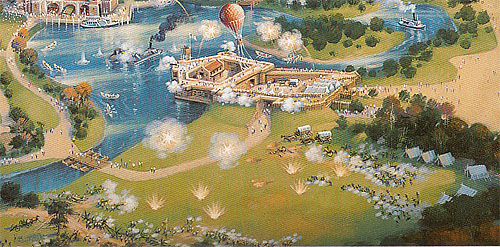
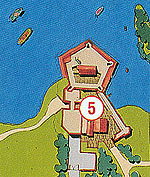 The Civil War Fort would provide a look at the most contentious period of American history outside of the closure of Mr. Toad’s Wild Ride. Inside the fort, WDI had planned a Circlevision 360 film to surround guests with a the scenes of a Civil War battlefield. The area around the fort would host period battle reenactments, and on Freedom Bay the park would stage a “thrilling nighttime spectacular” based on the historical battle between the ironclads Monitor and Merrimac.
The Civil War Fort would provide a look at the most contentious period of American history outside of the closure of Mr. Toad’s Wild Ride. Inside the fort, WDI had planned a Circlevision 360 film to surround guests with a the scenes of a Civil War battlefield. The area around the fort would host period battle reenactments, and on Freedom Bay the park would stage a “thrilling nighttime spectacular” based on the historical battle between the ironclads Monitor and Merrimac.
We The People (1870-1930)
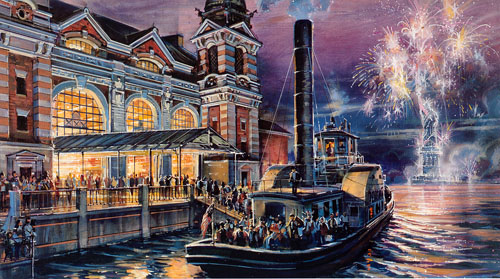
 Another of the park’s multimedia attractions, We The People was housed in a building that replicated New York City’s famous Ellis Island facility. The show would attempt to describe the immigrant experience and depict how the conflict between these various cultures helped to shape America. The guest experience would be enhanced by various ethnic foods and music available inside the facility.
Another of the park’s multimedia attractions, We The People was housed in a building that replicated New York City’s famous Ellis Island facility. The show would attempt to describe the immigrant experience and depict how the conflict between these various cultures helped to shape America. The guest experience would be enhanced by various ethnic foods and music available inside the facility.
As an indication of how the park’s design would shift after the time of the original announcement, by 1994 Disney Imagineering had started to conceive of this as a more humorous attraction. As an attempt to lighten the rather heavy message and to include the Muppets in the park (they were just beginning a decade of contentious negotiations with Disney), WDI considered telling the American immigrant story through the use of Henson’s creations. Neither version would ever come to pass.
Enterprise (1870-1930)

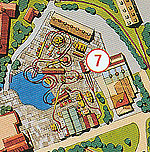 The territory of Enterprise would pay tribute to the industrial expansion and economic boom that fueled America’s rise to world power. The key attraction in this area would be a rollercoaster called Industrial Revolution. The coaster would twist in and around a turn of the century steel mill, and climax with an escape from a glowing vat of molten steel. Later reports indicate that this ride might eventually have been canceled; Eisner indicates in his memoir Work In Progress
The territory of Enterprise would pay tribute to the industrial expansion and economic boom that fueled America’s rise to world power. The key attraction in this area would be a rollercoaster called Industrial Revolution. The coaster would twist in and around a turn of the century steel mill, and climax with an escape from a glowing vat of molten steel. Later reports indicate that this ride might eventually have been canceled; Eisner indicates in his memoir Work In Progress that it was thought that the ride could “trivialize and even demean the attempt to portray the steel mill realistically.”
As an attempt to smooth over relations with historians, Disney eventually tried to separate the serious themes they were trying to tackle in parts of the park from some of the more “frivolous” theme park attractions they were designing. As Eisner later said, “it was fine to create a Lewis and Clark raft ride, for example, but not to try to explain Manifest Destiny as part of the same experience.” Industrial Revolution might have been a casualty of these changes.
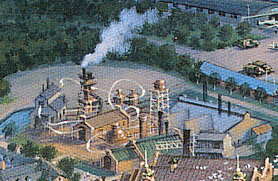 One aspect of the Enterprise area that does not appear in any literature but I personally feel was inevitable was some sort of factory tour. Eisner’s obsession with factory tours is well known, and over his career he would try to incorporate them into the Florida property and would eventually succeed with squeezing a few into California Adventure. While I have nothing to support this speculation, I feel that Eisner would definitely have tried to incorporate his ideas for “America’s Workplace” somewhere into this park, and Enterprise seems as good of an area as any to do it.
One aspect of the Enterprise area that does not appear in any literature but I personally feel was inevitable was some sort of factory tour. Eisner’s obsession with factory tours is well known, and over his career he would try to incorporate them into the Florida property and would eventually succeed with squeezing a few into California Adventure. While I have nothing to support this speculation, I feel that Eisner would definitely have tried to incorporate his ideas for “America’s Workplace” somewhere into this park, and Enterprise seems as good of an area as any to do it.
Victory Field (1930-1945)

 Victory Field represented wartime America from the vantage point of a military airfield. While sounding like one of Disney’s America‘s most exciting areas, it is also one of its most nebulous. What exactly is this spectacular sounding E-ticket attraction? What technology would it be based on? What ride system would allow guests to “find themselves piloting a World War II fighter by way of virtual reality”? To parachute from a plane or operate tanks and weapons in combat? None of the park announcements were ever specific (note also that the park’s train system would stop in this area).
Victory Field represented wartime America from the vantage point of a military airfield. While sounding like one of Disney’s America‘s most exciting areas, it is also one of its most nebulous. What exactly is this spectacular sounding E-ticket attraction? What technology would it be based on? What ride system would allow guests to “find themselves piloting a World War II fighter by way of virtual reality”? To parachute from a plane or operate tanks and weapons in combat? None of the park announcements were ever specific (note also that the park’s train system would stop in this area).
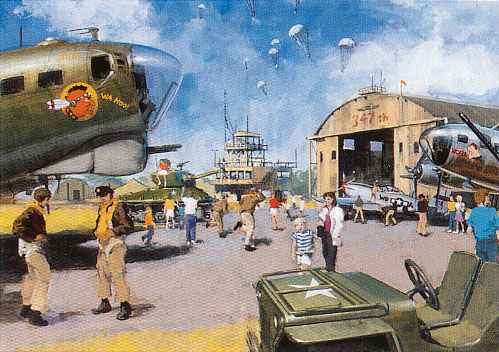
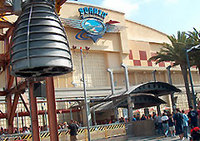 Much like Lewis and Clark, the Victory Field theme might look familiar to Disney fans. It too was mined for California Adventure, this time as a thematic basis for the Condor Flats area. While Condor Flats is a modern-day Mojave desert airfield instead of a WWII airstrip, many visual elements were retained. This won’t last for long, though, as the entire area looks to be completely rethemed as part of Phase II of California Adventure’s impending facelift. The cornerstone of this area at DCA is Soaring over California – could this be a descendant of the ride system intended for Victory Field?
Much like Lewis and Clark, the Victory Field theme might look familiar to Disney fans. It too was mined for California Adventure, this time as a thematic basis for the Condor Flats area. While Condor Flats is a modern-day Mojave desert airfield instead of a WWII airstrip, many visual elements were retained. This won’t last for long, though, as the entire area looks to be completely rethemed as part of Phase II of California Adventure’s impending facelift. The cornerstone of this area at DCA is Soaring over California – could this be a descendant of the ride system intended for Victory Field?
State Fair (1930-1945)
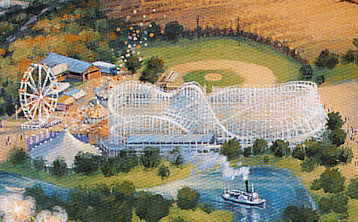
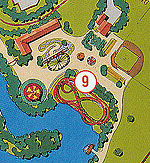 Sound familiar? No, not the part about the baseball – the rest of it. Again we come across another of Eisner’s perpetual fetishes – the seaside amusement park with whitewashed wooden roller coaster and ferris wheel. He tried to build it here, he tried to build it at Walt Disney World’s Boardwalk, and he was eventually able to shoehorn it in at California Adventure. Gentlemen, behold:
Sound familiar? No, not the part about the baseball – the rest of it. Again we come across another of Eisner’s perpetual fetishes – the seaside amusement park with whitewashed wooden roller coaster and ferris wheel. He tried to build it here, he tried to build it at Walt Disney World’s Boardwalk, and he was eventually able to shoehorn it in at California Adventure. Gentlemen, behold:
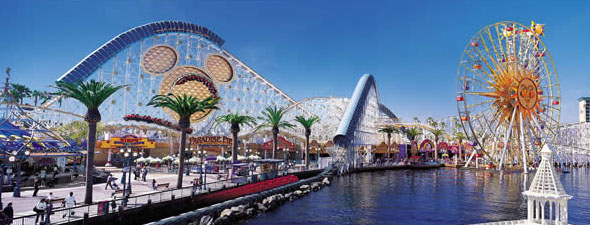
As we round the lake towards this territory and the rest of Disney’s America, we can see that the budget is slowly running out. Although the cost of the park would rise 40 percent beyond these original plans, by the time you’re trying to sell people on exhibition ball games you’re probably trying to stretch a penny.
Still, in the context of the park as a whole and with some highly themed details even this humble area might have been a cool addition to the Disney park canon. Even the most cynical thrill-ride freak would probably be entertained by sitting back with a hot dog and watching some baseball as cornfields stretched over the rolling Virginia foothills into the horizon. Also of note is that in the renderings there appears to be a carousel or other circular midway ride next to the roller coaster; with a great deal of plussing and placemaking this could have been a far more authentic and atmospheric instance of Eisner’s midway concept than California Adventure wound up with.
Family Farm (1930-1945)
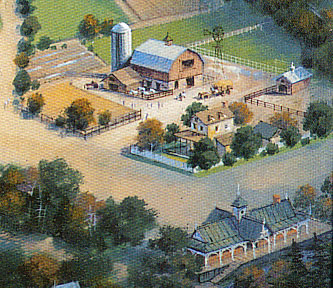
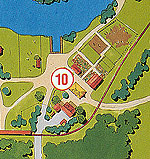 As we cross to the other side of Freedom Bay, we reach the last of Disney’s America‘s territories. The Family Farm reflects, along with factories and seaside pleasure piers, one of Michael Eisner’s fascinations. Family Farm is one of the least defined areas of the park, and one of the least likely to be found in a traditional theme park. There are no attractions per se, although the park’s railroad does stop here. Instead, there are a number of exhibits and demonstrations centered around rural life, including the harvesting of crops or milking of cows and the making of home-made ice cream. The area seems to focus on participation; it is said that guests can “even participate in a nearby country wedding, barn dance and buffet.”
As we cross to the other side of Freedom Bay, we reach the last of Disney’s America‘s territories. The Family Farm reflects, along with factories and seaside pleasure piers, one of Michael Eisner’s fascinations. Family Farm is one of the least defined areas of the park, and one of the least likely to be found in a traditional theme park. There are no attractions per se, although the park’s railroad does stop here. Instead, there are a number of exhibits and demonstrations centered around rural life, including the harvesting of crops or milking of cows and the making of home-made ice cream. The area seems to focus on participation; it is said that guests can “even participate in a nearby country wedding, barn dance and buffet.”
What would have actually emerged from this is unsure, as is whether any real attractions would be added to the area. It’s no coincidence that this area bears a resemblance to the Bountiful Valley Farm from California Adventure; that too was a throwaway area intended as cheap filler – and entirely lacking of even the small things that would have made Family Farm interesting. California Adventure’s farm area lasted hardly a year before before being converted into “a bug’s land”; one wonders if Family Farm would have had a similarly Pixarified fate.
Phase II?
Nothing concerning Disney’s America‘s future plans were ever released to the public; opening day plans were still quite up in the air when the park was canceled. Rarely do Disney fans receive such a detailed look into a park more than four years before its opening – much of what we know about this park would have changed before it opened. We can speculate, though.
As mentioned earlier in this article, Disney’s America was lacking a central visual icon along its entrance route. I’m sure that WDI would have looked at ways around this, although I’ve never heard anything about what this icon might be. The park is also lacking in family attractions, something that has plagued most new non-“Magic Kingdom” Disney parks since 1982. The Bountiful Valley Farm area at California Adventure was eventually filled with kiddie rides and converted to “a bug’s land”; as I’ve suggested this could be done to the Family Farm territory as well. Or WDI could have dusted off the older plans for a Sleepy Hollow themed dark ride; similar Fantasyland-style dark rides could be designed around any number of Disney’s animated American legends such as Pecos Bill, Paul Bunyan, Johnny Appleseed or John Henry. This would also help the fact that the park lacks any traditional Disney dark rides, another drawback of the post-1982 parks. Dare I even suggest Western River Expedition?
One thing is for sure – there was plenty of room for expansion. Look on your park map and notice how far that train track looped out into the wilderness; there was lots and lots of room inside the berm for whatever WDI could cook up.









This project might not be so dead after all and could even wind up being in Virginia, just in a different location.
http://virginiavirtucon.wordpress.com/2008/07/17/revive-disneys-america-in-virginia/
It’s a shame the park went down the way it did, especially considering the sprawl now threatening the sacred lands of Manassas.
Still, maybe Disney did dodge a bullet, considering the unpredictable climate in the area. There’s a reason Walt didn’t want to build WDW outside of New York and Philadelphia, even if the 50 million people within 3 hours of both cities would visit the park. The weather is unpredictable and can be quite harsh, and may have cut into the operating hours of the park. I would love to see an American Disney park in snow, and this park would be perfect to pull it off, but considering the ice storms to the south and the blizzard-type storms that occur to the north, maybe Disney was better off not building this park in Virginia.
I agree that it’s a shame things worked out this way – as you say, the entire area is going to be consumed by development and it’s ironic that the area would arguably have been much better preserved had Disney taken control of the land.
Being from North Carolina, I know what you mean about the unpredictable climate. Of course other parks in the area are seasonal, but I’d have to go back through my research to see if Disney ever said what their plans were on this front. I’m with you one one thing for sure – I’d love to see a Disney park in the snow. Heck, the idea of a Disney-themed park on the rolling hills of the Piedmont in autumn gives me chills…
[…] vary somewhat, but still follow fairly similar themes. We’ve already touched upon the story of Disney’s America, as well as the process that led WESTCOT to be downsized and eventually […]
[…] the immediate thing that most Disney fans will think of upon hearing this news is the aborted Disney’s America project of years ago; this project obviously has no relation to that park design, and will consist […]
I have in my attic one of the (I believe) very few zoning applications, all four thick binders, Disney supplied to the state of Virginia for their Disney’s America project. As you can imagine, it’s stuffed full of artist renderings, maps, studies, descriptions, etc. Somebody has just offered to buy it from me and I have no earthly idea how valuable this might be. Do you have any insights into this?
Thank you for your help and best to you,
Ted
Hi there,
Unfortunately I have *no* idea how much something like that would be worth; because of its scarcity it’s one of those “priceless” things that are hard to assign value to. I’m sure it would bring a hefty price on eBay, though, so it’s definitely worth quite a bit. Sorry I can’t help more – I wish I could pick one up for myself!
[…] 1 2 3 4 […]
[…] July 18, 2008 at 7:45 pm · […]
[…] http://progresscityusa.com/2007/11/22/thanksgiving-special-neverworlds-part-i-disneys-america/ […]
[…] http://progresscityusa.com/2007/11/22/thanksgiving-special-neverworlds-part-i-disneys-america/ […]